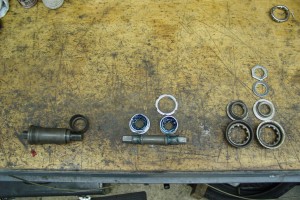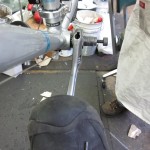 Quality bottom bracket bearings (BB from here on) are pretty much cartridge units these days. When they do go bad you simply replace them. Gone is the necessity of worrying after a rainy ride that you might have to overhaul the thing at your earliest possible inconvenience. Given their ease of maintenance however, they are often overlooked until absolutely necessary.
Quality bottom bracket bearings (BB from here on) are pretty much cartridge units these days. When they do go bad you simply replace them. Gone is the necessity of worrying after a rainy ride that you might have to overhaul the thing at your earliest possible inconvenience. Given their ease of maintenance however, they are often overlooked until absolutely necessary.
Making sure the threads are well lubed and that the unit is tight in the frame can make a world of difference. Many new units (especially outboard bearing versions) will even come with torque specs. But consider this: this is the one part that transmits all of the riders power and weight when in use. Make sure the fixed cup side is tight in the frame before installing the other cup. The BB should be tight. I generally prefer grease/ anti seize which actually can help torque them in better and the drive side- depending on BB cartrdge type- is generally more important to get tight.
It is very difficult to actually strip threads simply by installing tightly unless they are already damaged. I use to ride bikes with italian threading (clockwise on both cups)- as have many people- and never had an issue with them loosening- and I’m not the weakest/ lightest of riders. The issue stems from under tightening a part designed to transfer all of the above mentioned forces. Be sure to tighten the cup leveraging against the whole frame and NOT just THE SEAT TUBE CLAMPED IN THE BIKE STAND. If the bike is clamped by the post you can often leverage against your body by holding the frame (underarm/ leg sometimes works depending on frame size), with wheels on the ground or in a vise. All too often frame tubes are bent from torquing them against the stand arm or even when the bike is clamped by the seatpost.
with wheels on the ground or in a vise. All too often frame tubes are bent from torquing them against the stand arm or even when the bike is clamped by the seatpost.
Outboard bearings seem to be less finicky with Re: to tightness (although benefit from a nice shell facing) and do often come with torque specs. Teflon tape may work great on these units but put something on the threads and tighten them down to spec.
TIP: Barring tapping the threads to Italian when you have a stripped d-side BB shell (often from riding loose), consider a non-drive side tightening Shimano cartridge (LP series) or a BB which cinches itself together in the frame (Velo-Orange or an old Mavic if you just happen to have one and the “facing” tool required for installing it)
A quick note on Ashtabula (one piece) cranks: tighten down the d-side cone against the chain ring if apart or installing. They are very often loose. Otherwise these BBs are pretty reliable- albeit clunky/ heavy-
